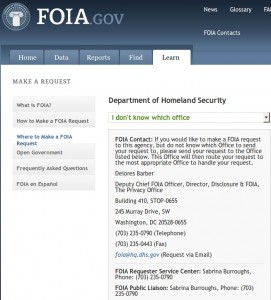TSA takes a (small) step in the right direction
Earlier this month, the TSA announced that — although of course there are still no rules for what is and isn’t permitted at TSA checkpoints, travelers can expect that beginning April 25th we will be “permitted” (not entitled, “permitted”, since of course the exercise of our right to travel is at the TSA’s discretion) to bring tiny pocket knives and certain previously-prohibited sporting equipment onto commercial airplanes.
We could criticize the TSA’s press release for not going far enough, and for its arbitrariness. (We’d like to say that it’s a “policy” change, but we can’t, since there are no publicly-disclosed TSA checkpoint polices.) It’s pretty obvious that it doesn’t reflect any rational risk assessment. Why allow golf clubs, hockey sticks, and pool cues, but prohibit cricket bats?
But lest it be said that we never give credit to the TSA when credit is due: We congratulate the TSA for taking a small step toward saner “screening” practices.
Unfortunately, the TSA’s announcement has prompted a hysterical reaction from the opposite direction, with bills being introduced in both houses of Congress to direct the TSA to seize even the tiniest blades, and to protect us against the hockey-stick-armed terrorist hordes.
Ironically, the TSA defends itself with an argument that could equally be used against virtually all of the TSA’s continuing restrictions on carry-on items:
We have yet to see a single incident where a passenger was injured using a knitting needle or scissors. Small knives have been permitted in Europe for some time now, with no incidents that we are aware of. In fact, the GAO published a report that said there had been zero security incidents where these items had been used aboard an aircraft.
Passengers are allowed to bring bottles of water and many other items prohibited by the TSA onto flights in Europe and the rest of the world. We are aware of no incident in which anyone has tried to blow up or highjack an airliner using a bottle of water as a weapon. So if this is the TSA’s criteria, what is the rationale for the list of items that are still prohibited in carry-on luggage?
The fact is that searches at TSA checkpoints, like most other “administrative” searches, are designed as security theater — to make us feel safer rather than to make us be safer — and for a variety of other law enforcement purposes (mainly seizure of prohibited substances). Not on the basis of aviation security.
Would-be terrorists would have a hard time breaking through reinforced cockpit doors. Those with adequate cutting tools would probably be subdued (and possibly lynched) by passengers and flight attendants before they could do so. These, and not TSA checkpoints, are the real defenses against the bogeyman of “another 9/11”.
Even the prohibition on firearms on airline flights has more to do with gun control in general than with anything specific to aviation security. The TSA boasts that it finds loaded guns in carry-on bags every day. Does that suggest that every gun-toting traveler is a terrorist? Or that travelers have been flying with firearms every day for decades, almost entirely without incident? It’s hard to see how a gun poses more of a threat on an airliner than, say, in a crowd (or in a car) on a city street, where it’s perfectly legal.
We salute the saner voices among the secret decision-makers who determine the TSA’s secret non-rules. We urge them to stand firm in defense of our right to keep our sewing scissors and pencil-sharpening knives in our carry-on bags, and to resist the pressure to pander further to Congressional fears.
